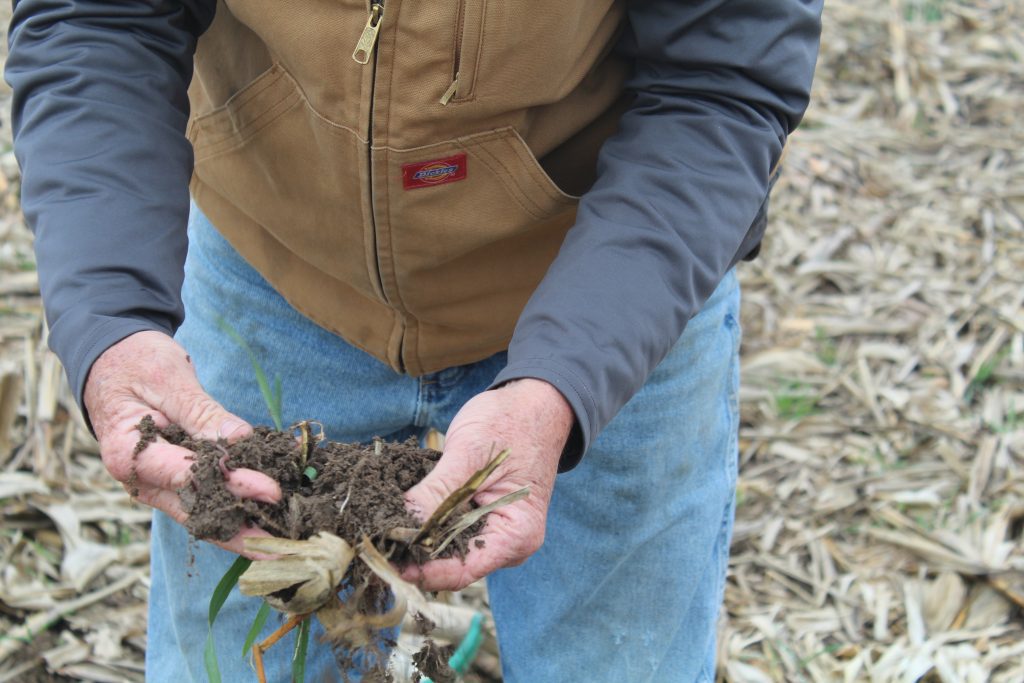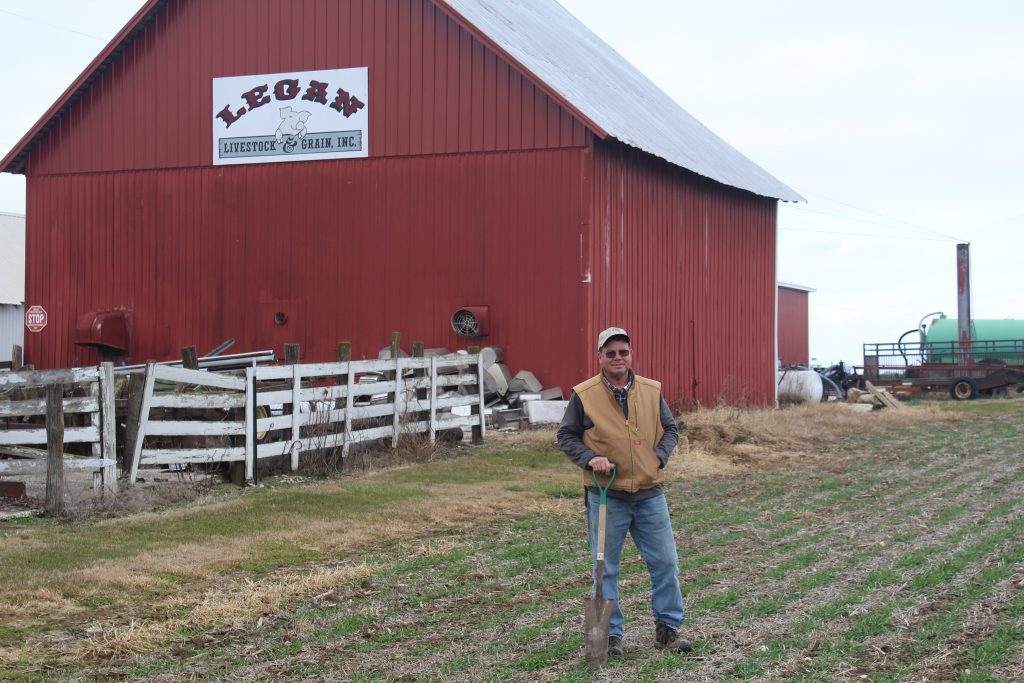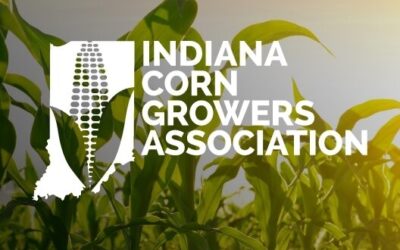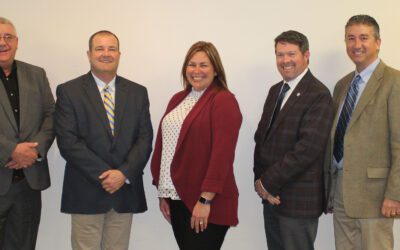Legan family recognizes value of on-farm conservation practices
By Amie Simpson
First-generation farmer Mark Legan has adopted conservation practices on his Putnam County operation with the next generations in mind. Mark and his wife Phyllis began Legan Livestock and Grain in 1989 and were joined by their daughter, Beth, and son-in-law, Nick, in 2010. That’s when the family established core values for the farm that they still adhere to today.
“One of the core values is integrity, and we define that as doing what’s right when no one is looking,” Legan said. “Another is relationships. We wouldn’t be farming today if it wasn’t for the relationships we have with other farmers and input suppliers. The third core value is stewardship. We define stewardship as taking care of the land, water, pigs, employees, and community. Last, but certainly not least, is continuous improvement. We want to be better tomorrow than we are today. We want to learn all we can and apply that to make our farm more efficient and sustainable for the future.”
Legan, an Indiana Soybean Alliance (ISA) board member, said it all boils down to protecting natural resources through conservation practices like no-till and cover crops with the goal of ensuring that his daughter and son-in-law and then grandchildren, if they choose to, can continue to farm. They have been no-till planting some of their acres since they started farming. Today, they are 100 percent no-till, with exceptions to level tiled ground out.

The family also plants cover crops. Legan said they mainly started using cover crops to tie up nitrogen from fall-applied manure. Cereal rye, which is planted in the fall and provides a three-to-four-foot soil cover by the spring, has worked the best on his operation. He added that they saw the benefits of cover crops, especially following soybeans, and worked up to planting cover crops on all acres.
“Cereal rye allows us a lot more options in the springtime when it comes to terminating it. In the past, we have used several different cover crop species,” he said. “We’ve also used a variety of seeding methods over the last 15 years. Whether that’s aerial seeding at the end of August or September or applying cover crop seed with fertilizer and incorporating that with a vertical tillage tool. We finally bought a Hiniker Air Seeder and we have been able to cut cereal rye rates to one-third of what we were using with broadcast applications.”
Legan said they will continue to utilize sustainable conservation practices on the farm to improve the environment and their bottom line. “I have a quote above my desk from former Purdue University Ag Economist Chris Hurt that says, ‘returns go to management in farming, returns don’t go to tractor drivers.’ That’s why we are trying to apply management principles that are a little more complex than just going out and tilling the soil,” he said. “By doing that it’s better for the soil, it’s better for water quality, and we’re able to cut our machinery costs drastically as well as the fuel and labor for land preparation. That’s probably one of the main reasons we got involved with no till. We started with limited capital and labor, and it seemed like a way that we could make that work on a larger scale.”
In 2024, the family is considering drone seeding cover crops and changing some residual herbicides used in soybeans. They will also continue to apply manure fertilizer to their fields to provide necessary nutrients to the crops.
Economic, environmental benefits of manure application
For the past three years, Legan Livestock and Grain has participated in an on-farm sustainability analysis with the National Pork Board.
The goal of the analysis is to quantify management practices on the farm and how that relates to soil quality, soil erosion, and water quality. Legan said the analysis considers the liquid manure fertilizer they apply to the field and the fertilizer that they have purchased.
“Each year, about one quarter of our acres receive manure applications. The average cost savings from manure applied to 240 acres is about $80 per acre in fertilizer cost,” he said. “(The Sustainable Environmental Consultants) also calculate our greenhouse gas emissions. We’re sequestering about one third a ton of soil carbon per year across all our acres and our erosion rate is one half a ton per acre. The USDA calculates the average erosion rate in Indiana cropland as 3.2 tons per acre.
“We’re well under the state average and the state average is well under the national average of 4.6 tons of soil loss per acre. While we are losing half a ton a year, I believe the T value for soil, which represents the maximum annual rate of soil erosion that could occur without causing a decline in long-term productivity, is generating 2 tons of soil per year and by sequestering this carbon we’re building organic matter in the soil.”
The family started participating in the on-farm sustainability analysis so they could begin benchmarking their farm’s sustainability index.
“We feel that at some point it will add value to our customers, grain, and pork and hopefully result in increased returns to us,” he said.
Legan said it is helpful to be able to quantify the environmental aspects of the practices they are implementing, compare it year over year, and then use the data to inform decision-making on the farm.
For more information about National Pork Board’s effort visit porkcheckoff.org/pork-production-management/sustainability/.
Those interested in participating or using a similar tool, contact Madeline Lilly, the sustainability and value creation project manager with Indiana Soybean Alliance, to find out if you’re a candidate for the 2024 pilot at mlilly@indianasoybean.com.
Sharing conservation data with farmers
There is a learning curve to changing management practices like no-till or cover crops. Legan says they are fortunate that neighboring farmers have been open to sharing information.

“Having a group of peers that we can share information with about what did and didn’t work in a year is important,” he said. “We’re trying to do the best we can, not only for our bottom line, but also for the soils and environment. When you look at the soil resources that we have in the Midwest, we’re very blessed. But soil degradation does occur over the years if we’re not instituting conservation practices to control erosion and protect the health of the soil.”
The advice he has for farmers interested in planting cover crops, switching to no-till, or using other conservation practices is to have an open mind, a good attitude, and to start small.
“I believe that farmers going into changing tillage systems or management practices with the idea that they’re going to make it work, will make it work. On the other hand, it generally does not work out if someone is skeptical and goes into it thinking it isn’t a good idea. Start small when making changes because there’s a learning curve and not every year is going to be the best-case scenario. We want to make our mistakes on a small-scale,” he said.
Legan said the family will continuously work to find new ways to leave the farm better than they found it.
Interested in implementing some conservation practices on your farm? Reach out to Joe Rorick, ISA on-farm sustainability programs and research coordinator at jrorick@indianasoybean.com for more information or check out our on-farm conservation page to see available programs for farmers at the link below.
Posted: January 13, 2024
Category: Indiana Corn and Soybean Post - January 2024, ISA, News, Sustainability




